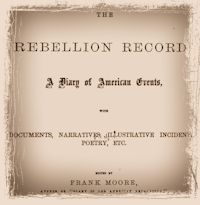June 17.—A body of rebels crossed the Ohio River and advanced on Corydon, Paoli, and Orleans, Indiana. At the latter place they were met by the Paoli home guards, who dispersed and drove them back to the Ohio River, where, being prevented recrossing by the presence of an armed steamer, the whole band was captured.— (Doc. 12.)
—A Union mass meeting was held at Concord, N. H., probably not less than twenty thousand people being present. A procession composed of military and civic organizations and the citizens of the State generally, with numerous bands of music, marched through the principal streets to State House Square, where the meeting organized by choosing Ira Perley, President, with twenty Vice-Presidents.
A series of resolutions were adopted, pledging support to the Government in putting down the rebellion. The fourth resolve was as follows:
“That the men of the loyal States, who, by word or deed, directly or indirectly, under whatever pretence or disguise, discourage the recruiting and maintaining of our army and navy, or in any other way lend their aid to schemes calculated to embarrass the Government in this crisis of the national life, ally themselves with the rebellion and are traitors at heart.”
Eloquent addresses were made by Major-General Butler, Montgomery Blair, General Hamilton, Ira Perley and others.
—The Seventh, Eighth, and Seventy-first regiments of New-York State militia, left New-York for the seat of war in Maryland and Pennsylvania.—Robert Toombs delivered a speech at Sparta, Ga., on “The state of the country.”— General Blunt issued an order forbidding the circulation of the Caucasian, Chicago Times, Columbus Crisis, Cincinnati Enquirer and New York World in his department.—A fight took place at Aldie, Va., between the National cavalry under General Gregg, and the rebels under General J. E. B. Stuart—(Doc. 74.)
—A body of rebel cavalry crossed the Potomac near the Point of Rocks, and moved upon that place, at which there was no force of defence, except Captain Means’s irregular local cavalry. All these were captured, including the Captain himself.
Simultaneously another body of the enemy, mounted, crossed the river higher up, and attacked Major Coles’s cavalry at Catoctin Station, about seven or eight miles east of Harper’s Ferry.
About the same time a part of the enemy’s cavalry charged upon a military train, and succeeded in its capture. It consisted of one first class locomotive and about twenty-three cars, returning from Harper’s Ferry to Baltimore, after having carried provisions to supply the garrison during the day. Fortunately this was the last train of a convoy of five, the others having just preceded it in safety, and all reached Baltimore. Of the captured train were several cars loaded with produce that was being rescued from danger from the vicinity of Harper’s Ferry, also some fifteen passengers who took advantage of the train either to escape, or else business connected with the army required them to come down the road.—Baltimore American, June 18.
—The iron-clad gunboat Chattahoochee, belonging to the rebels, was destroyed at Chattahoochee, Florida, by the bursting of her boiler. A correspondent of the Charleston Courier gives the following account of the affair:
“The schooner Fashion, at anchor in the Chattahoochee River, twenty-five miles above Apalachicola, was loading with cotton, and intended to run the blockade. She had received sixty bales of Sea-Island cotton, and was awaiting for another arrival from ——, when a spy or some traitorous person conveyed the fact to the enemy’s fleet blockading. The result was, that the enemy sent nine launches with armed men, captured the schooner with the cotton on board, and took her to the fleet. When the news reached Chattahoochee, Lieutenant Guthric, commanding the confederate States ironclad gunboat Chattahoochee, ordered steam to be raised, and was determined to pass the obstructions in the river, if possible, with a view of attacking the United States steamer, and endeavor to relieve the Fashion. Just as the steamer was leaving her anchorage, her boilers exploded, and twelve persons were killed, while several others were badly scalded.”
—A portion of two companies of the Ninth regiment of Kansas volunteers, numbering seventy men, while on the march from Paola to Kansas City, were fired on at a point about four miles south-west of Westport, Mo., by a large party of rebels in ambush, and suffered a loss of ten killed and seventeen wounded and missing. The National troops who were under the command of Captain Fletcher, were obliged to fall back to Olathe.
—H. Pinkney Walker, Her Britannic Majesty’s Vice Consul, at Charleston, S. C., having submitted to the Secretary of State satisfactory evidence of his appointment as Acting Consul for the States of North and South-Carolina, is recognized as such by the government of the confederate States.—Lynchburgh Republican, June 18.
—The rebel ram Atlanta was captured in Warsaw Sound, Ga,, by the National monitor Weehawken, under the command of Captain John Rodgers.—(Doc. 18.)
—Cumberland, Maryland, was occupied during a portion of the day by a party of Imboden’s rebel cavalry, who visited the various stores in town, and made large purchases of boots, shoes, and clothing, paying for the same in rebel scrip, at a heavy discount. Several young men belonging to the town joined the rebels and left with them on their departure, which took place at an early hour in the forenoon.—Cumberland Union, June 20.



